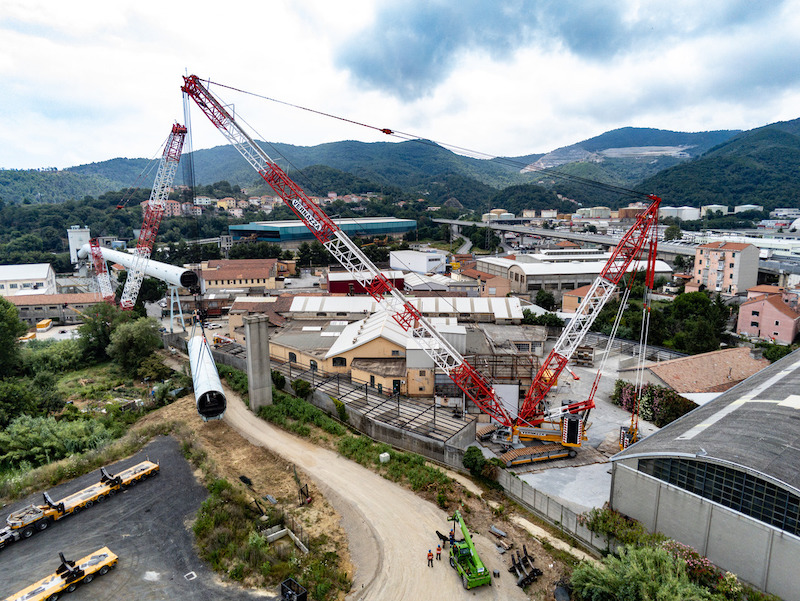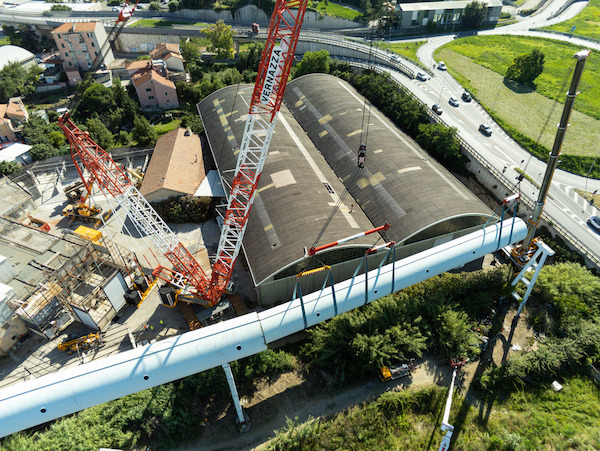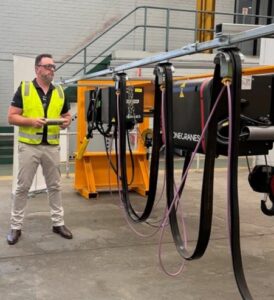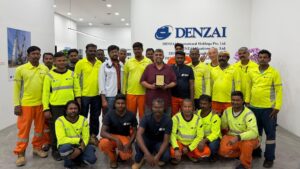Vernazza Autogru has relied on a Demag CC 3800-1 lattice-boom crawler crane to dismantle the enclosed coal conveyor belt at the power plant in Italy. Due to the cramped conditions at the worksite in the small town of Vado Ligure, suitable set-up spaces for the project were located some 70 meters from the load, making it impossible to use only telescopic cranes to efficiently execute the lifts of the heavy conveyor belt sections. The Demag CC 3800-1 from Vernazza Autogru’s fleet was therefore needed to get the job done. “Without a large, powerful crawler crane, there’s no way we could have done this job,” explains Engr. Giulia Vernazza of Vernazza Autogru.
However, before the coal conveyor system at the decommissioned ‘Tirreno Power’ plant could be dismantled, the Demag crawler crane had to be transported to a worksite in the industrial district of Vado Ligure, using a total of 25 trucks. Due to the limited space available, the crane components and equipment were transported to the site in the order in which they were needed to assemble the crane. “The ease of assembly that sets the CC 3800-1 apart proved to be a decisive advantage,” says Giulia Vernazza. This was all the more important given the spacial constraints of the site, which were anything but generous. “Our five assembly technicians had to set up the crane with a 72-meter-long main boom, but they had an area of just 50 meters available to do so,” she explains. To achieve this, the final sections of the boom had to be assembled at height, using platforms made of concrete blocks and azobé wooden beams which were erected specifically for this purpose. For both the setup and lifting operations, Vernazza Autogru used its Demag AC 140, AC 160 and AC 800 all terrain cranes as assist cranes.
Despite the lack of space, the team was able to successfully set up the crane in SSL configuration and then in SWSL configuration and with a counterweight of 300 tonnes, and to ready it for use in the lifting operations necessary to disassemble the coal conveyor system. More specifically, the crane was to be used to pick up 60-meter-long sections of the enclosed conveyor belt, each of which had a diameter of 4.50 meters and weighed 2.5 tonnes per meter, lift them off their support structures, swing them to the side to be divided into sections of 20 meters each, and set them down on low-bed trailers. The lifts were performed at a height of 35 meters, with a working radius of 70 meters and in tandem with the assist cranes, in addition to the restricted space conditions described above. In addition to the considerable size and weight of the 150-tonne loads, the limited field of view made performing the lifts even more challenging. Careful planning, including spotters with radio contact, was therefore necessary.
“Despite all the obstacles, our five-person team was able to keep to the original schedule thanks to their wealth of experience and the precision of the Demag cranes – and that’s even though they first had to build proper access paths for the CC 3800-1 before being able to remove some of the sections,” says Giulia Vernazza. “We worked on site for a total of 20 days with our CC 3800-1, which once again proved that it’s simply a perfect piece of equipment: it’s easy to transport and set up, it works quickly and reliably, and it provides an exceptional level of safety with its fall protection system, which comes as standard. It’s no wonder that it’s our first choice for so many lifting jobs.”









